Quinoa Is a Bonafide Superfood—Here Are 6 Reasons to Love This Healthy Grain
The quinoa craze wasn't just a passing trend—it really is that good for you.
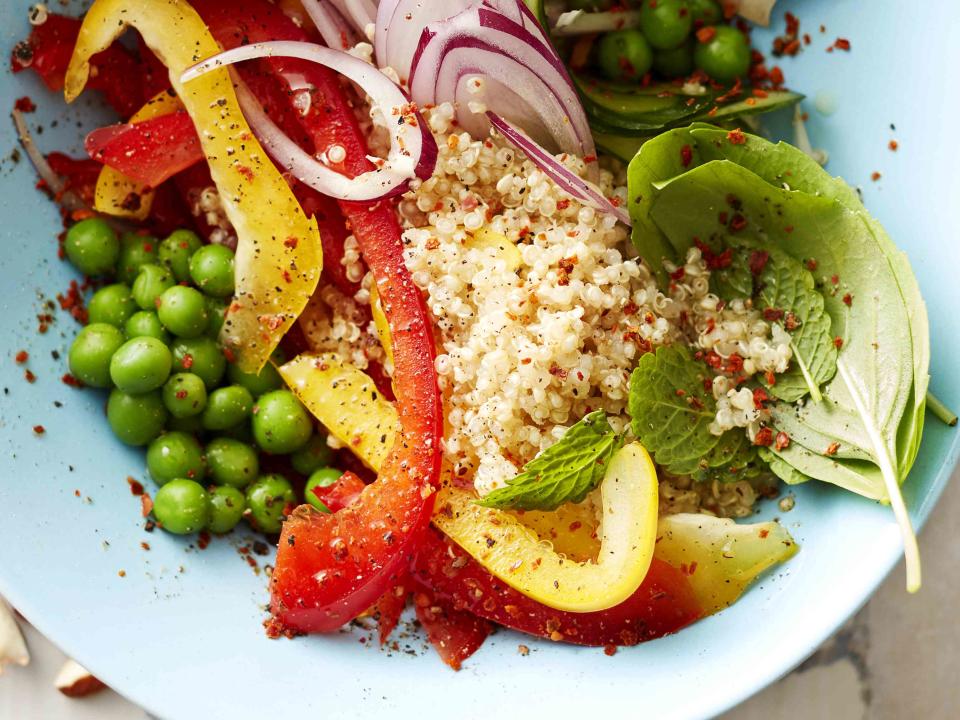
Westend61/Getty Images
Beyond being a delicious, satisfying, and versatile addition to both savory and sweet dishes, quinoa is a nutritional powerhouse that’s rightly earned its spot in the superfood hall of fame. “Quinoa is in a league of its own when it comes to whole grains. In the carbohydrate-conscious landscape we live in today, it offers a nutrient-rich alternative to [refined] foods like bread, rice, and pasta,” says registered dietitian Brianna Wieser, RDN, LDN, RYT, a lifestyle medicine expert and program design specialist at MOBE in Minneapolis, Minn.
Going back to its origins, quinoa is an ancient grain native to South America. Historical evidence shows that it was domesticated for consumption by the people of Bolivia and Peru between 3,000 and 5,000 BCE. Quinoa grows into tall, fluffy, cloud-like bundles resembling rock candy and thrives in environments where temperatures don’t exceed 90 degrees Fahrenheit.
The main types of quinoa that you’ll see on the market today are white, red, and black varietals, which can be combined to create tri-color or rainbow quinoa blends. While each of these quinoa types will have slightly different flavor notes, you can generally expect quinoa to bring a mild, slightly nutty taste to your recipes.
Alongside classic iPods, Blockbuster, and low-rise jeans, quinoa only really became popular and widely available in the U.S. in the mid 2000s. This is due, in part, to its impressive nutritional benefits, which are plenty and worth the hype. Here’s what you need to know about the nutritional benefits of quinoa, and why nutritionists recommend adding it into your regular rotation of healthy grains.
It's a great source of protein.
At the time when quinoa became so trendy, plant-based eating was gaining popularity, and all eyes were on protein—plant-powered protein. Unlike many other whole grain options, quinoa is a complete protein. This means that it contains all nine essential amino acids. Amino acids are the building blocks of protein that create all the vital structures in our bodies. Of the 20 amino acids that exist, nine cannot be created by the body and must be consumed, hence their esteemed “essential” title.
:8 of the Highest-Protein Foods Every Well-Balanced Diet Should Include
It's high in fiber and healthy fats.
When it comes to fiber, quinoa delivers. One cup of cooked quinoa provides five to six grams of fiber, putting a sizable dent into the recommended 25 to 35 total grams we should be consuming per day. One of the more recognizable kinds of carbohydrate, fiber is super important for gut health, managing cholesterol, and healthy blood sugar levels. Plus, quinoa is a source of omega-3 fatty acids, an anti-inflammatory fat that has been shown to help reduce blood triglyceride levels, aiding in maintaining or improving heart health.
It's rich in various micronutrients.
Quinoa not only offers the three key macronutrients—protein, healthy fats, and complex carbohydrates—but it equally measures up when it comes to micronutrients, like vitamins and minerals needed to function at our best. Here are a few vitamins and minerals found in quinoa:
Manganese: Vital for bone and metabolism function.
Magnesium: Important for healthy muscle functioning, blood clotting, blood pressure management, and bone function.
Copper and Zinc: Supportive of healthy immune function.
Iron: A key component to blood cell health.
Vitamin E: A potent antioxidant.
Phosphorus: Crucial for healthy bones, teeth, and cells.
B Vitamins like folate, thiamin, riboflavin and B6: Essential for healthy energy levels, growth, and development.
It's packed with phytochemicals.
When it comes to plants, their nutrition goes far beyond just macro- and micronutrient composition. Phytochemicals are plant compounds that encompass many different groups of antioxidants. At this point, there are already over 10,000 known phytochemicals in existence. Antioxidants are compounds that halt the chemical reaction known as oxidation that produces free radicals, which damage cells. Free radicals are the culprits behind inflammation, chronic disease, and major illnesses like cancer.
Quinoa has been found to be a great source of the phytochemicals quercetin and kaempferol, among others. Quercetin is a potential immune booster and anti-inflammatory agent, found to be protective against heart disease and cancer. Kaempferol also helps to reduce inflammation and preserve liver health while preventing metabolic diseases.
It promotes a healthy gut.
For those who struggle with gastrointestinal issues, quinoa is also for you. It’s an accessible, naturally gluten-free grain that we already know delivers in the way of complex carbohydrates. The fiber found in quinoa not only helps to regulate digestion but also acts as a natural prebiotic, feeding the healthy bacteria in your gut. A healthy gut microbiome is associated with improved health from almost every angle—from energy levels to brain and skin health, all the way to immune system function.
It helps regulate blood sugar levels.
The fiber and nutrients found in whole grains are associated with improved blood sugar regulation, which can help prevent diabetes or improve diabetes management. Quinoa, specifically, has been studied in relation to type 2 diabetes, found to be linked to reduced blood sugar spikes and an overall decreased risk of the disease with regular consumption. This is due to the fiber, protein, and healthy fat it contains, as these three elements are known to slow down digestion, naturally regulating blood sugar after eating.
Easy Ways to Eat More Quinoa
When thinking about how to start including more quinoa into your meals, Wieser offers some great advice: “Think about rice or oatmeal-based dishes that you already enjoy and begin subbing in quinoa for those grains or cereals.” Some great examples would be burrito bowls served over cilantro-lime quinoa, sauteed kale and broiled salmon with quinoa pilaf, or even a hot bowl of quinoa porridge with all the fixings in the morning. To get the most out of your quinoa, she suggests, “toast the quinoa in a sauté pan until slightly golden brown prior to cooking; it gives it a nice depth of flavor you wouldn’t get otherwise.”
As with most things, moderation is key. Including one to two cups of quinoa into your meals a few days per week is a great place to start. Here are some favorite quinoa recipes for inspiration:
Cheesy Baked Quinoa and Cauliflower
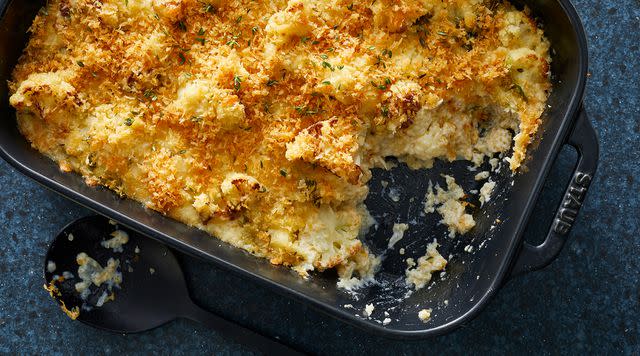
The best part about this creamy-cheesy-crispy casserole? You can make everything ahead of time. When you're ready to bake, pop the dish into the oven for comforting goodness in less than 20 minutes.
Mole-Spiced Black Bean and Quinoa Bowl
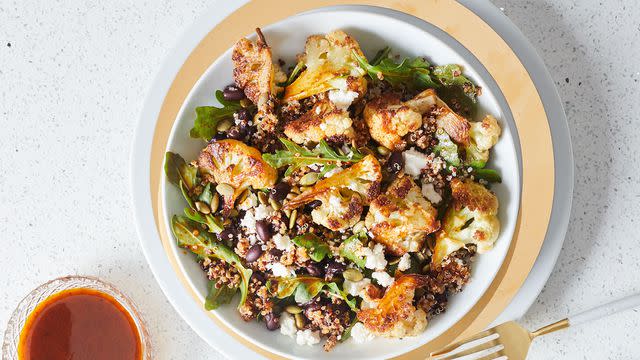
This vegetarian weeknight main uses jarred mole to make a flavorful Mexican-inspired bowl without the time (or ingredient) commitment.
Skillet Quinoa With Olives and Crispy Tofu
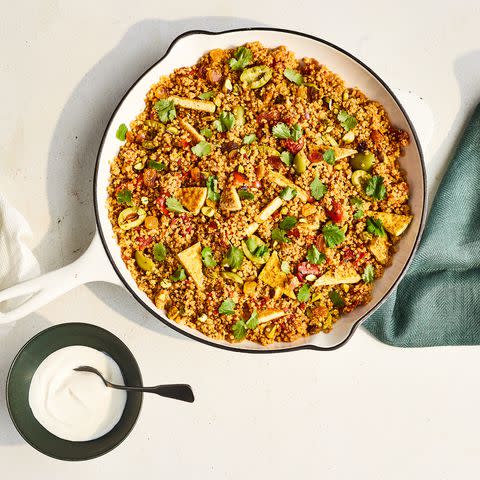
Ras el hanout is a fragrant Moroccan spice mix typically of cinnamon, cumin, coriander, and allspice that infuses complex flavor into quinoa pilaf and crispy triangles of tofu.
Nutty Superfood Breakfast Bites
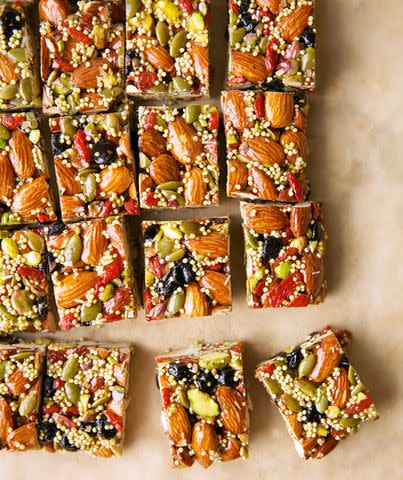
This is no ordinary energy bar. Almonds, seeds, quinoa, goji berries, and more superfood ingredients give these make-ahead breakfast bars plenty of flavor, texture, and nutritional perks.
Quinoa With Sweet Potatoes, Kale, and Pesto
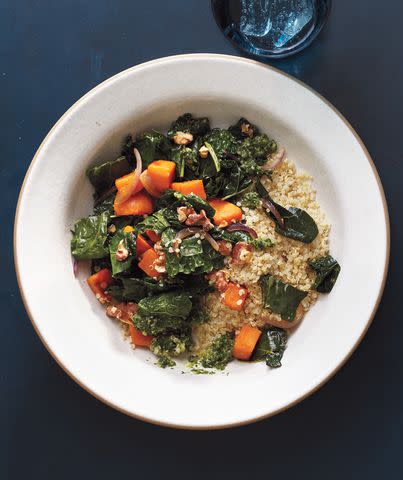
Just call this cozy dish fall in a bowl. Simple, yet satisfying, these quinoa bowls offer 14 grams of protein to keep you going.
Find more quinoa recipes right here.
For more Real Simple news, make sure to sign up for our newsletter!
Read the original article on Real Simple.

